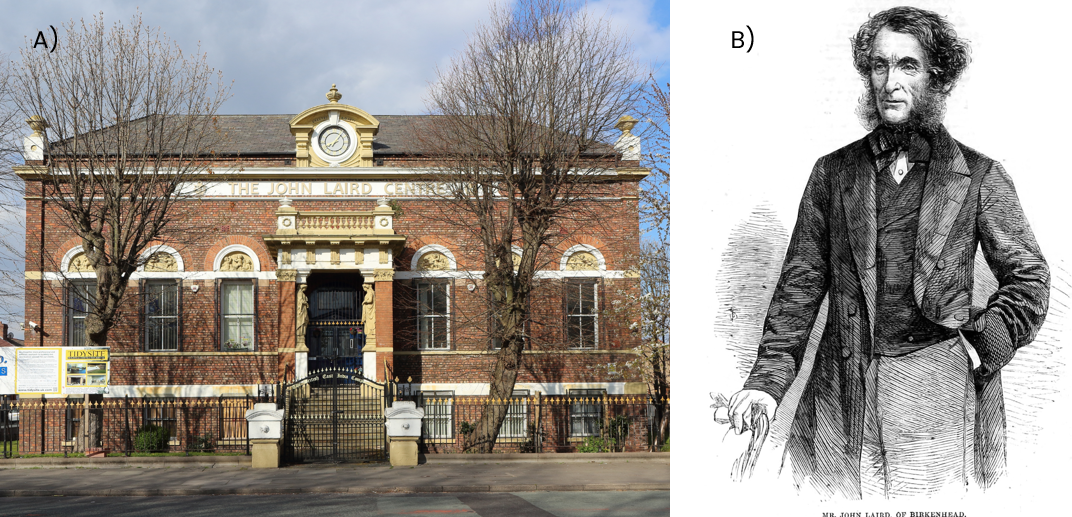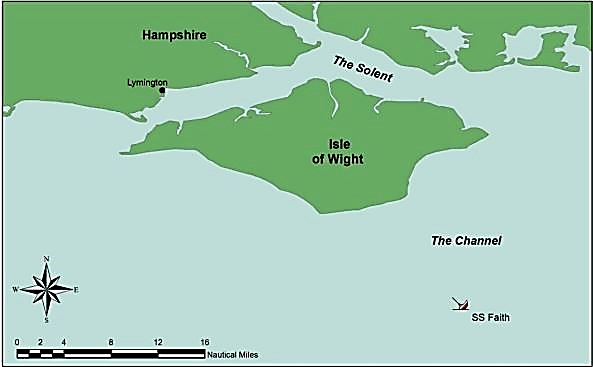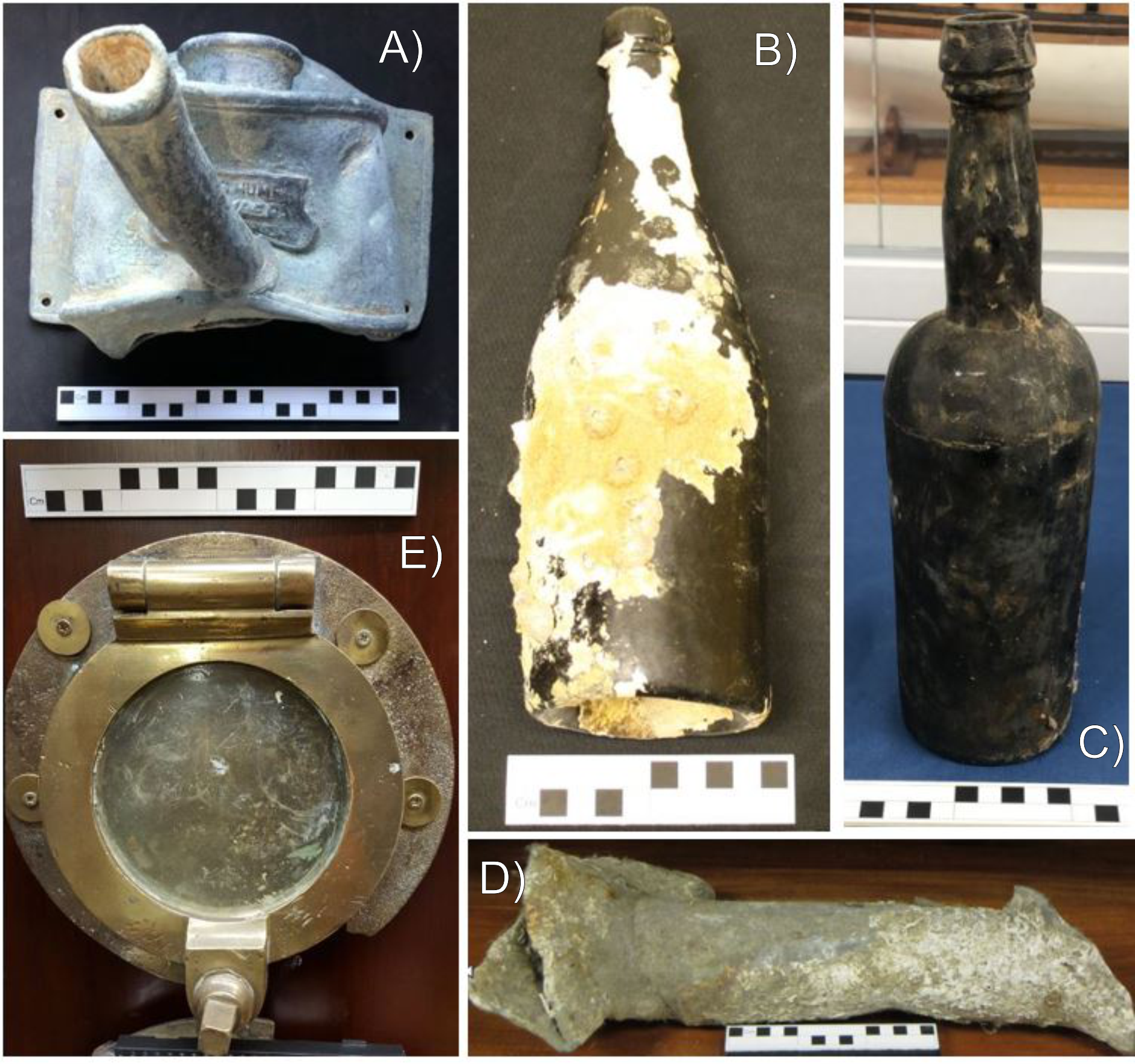Wrecked in 1855 off the Isle of Wight, and now a Protected Wreck due to rarity of its type, Volunteer Roger Burns investigates the builders, engine makers, and aspects of original anti-corrosion & fouling, additional to the detailed wreck diving report included below which led to its Protected status.
The SS Faith
Launched on 13 November 1852 by John Laird of Birkenhead for the African Steam Ship Co, the Faith was an early iron hulled steamer cargo ship having four watertight compartments and passenger accommodation, intended to serve the West African ports from the UK. 62.42m long, with 9.14m beam and 4.54m depth, it was rated at 894burthen and although too early for Official Number registration, it ‘belonged’ to the port of London, and later to Liverpool. When built, it was fitted with a simple two-cylinder steam engine, made by Fawcett, Preston & Co. Ltd. who were well established when the Faith was launched, as can be realised by reading this summary with more background here. The screw propeller could be disconnected in favourable wind conditions to utilise its Polacca rigged sails. Polacca rigging, a popular rigging arrangement in the Mediterranean in the 17th century, has a square-rigged foremast, whereas main and mizzen masts are lateen rigged, being triangular fore-and-aft sail.
The vessel had an elliptical stern above which was a half-length carved female figure – framing and plating was carried up from the stern to above the upper deck in an arch shape for a roofed wheelhouse and some more accommodation. Classified as a single deck vessel, there was a large topgallant forecastle for crew accommodation, and most of the spar deck was lined with cabins, equipped with ventilated windows.
The Builders
Coined in the media as a steam-boat building yard, the Laird shipyards had a distinguished history. John Laird was born in 1805 at Greenock but raised in Liverpool. His father William was an entrepreneur and established the Birkenhead Iron Works in 1824, moving into shipbuilding in 1828 with son John. The Shipbuilding database has the firm in different guises, mainly as Laird Brothers Ltd and William & John Laird, building an extensive variety of vessels such as barges, tugs, paddlers etc, primarily in iron and mostly steam driven. John was one of the first to use iron regularly in ship construction, his first being in 1829, a canal lighter, and in 1834 a paddle steamer named the John Randolph for the USA, the first iron ship to be seen there. His iron ship, for the East India Company, the Nemesis was the first in the world to carry guns. The yard eventually became Cammel Laird.
John Laird, Figure 1B, was a Conservative Member of Parliament 1861-1874, became a philanthropist, died in 1874, and was recognised for his contributions by having his Birkenhead College of Art named in his honour, Figure 1A.

Figure 1.A: The John Laird Centre, Source: Phil Nash from Wikimedia Commons CC BY-SA 4.0
Figure 1.B: Illustrated London News July 27, 1861, Source: Public domain, via Wikimedia Commons
Anti-Corrosion & Fouling
The hull was given two different treatments against corrosion and fouling. The lower part had an application of the then well known “Peacocks.” Manufactured by Peacock and Buchan at their base in Millbrook, Southampton, their product was being used and advertised extensively in the shipping and other industries. Their many advertisements were extensive and highly detailed, extracts from the British Newspaper Archive, including… “compositions for preserving the bottoms of Iron Ships from rust, barnacles, sea-weed …..also for preventing the destructive agency of worm on wood-bottom Ships and Boats, and the oxidation or wear of copper, zinc, galvanised iron and tallow metal sheathing. ….in use on all the steam fleet of the PO Company, the Royal Mail Company, and the Pacific Steam Company, and other companies ….. also lately coated on many of her Majesty’s Ships……several hundred private ships ….. including the Iron Steamer Great Britain…….and yachts and pilot sloops……..successfully applied to single bottom ships trading to New Orleans and the Mediterranean, effectively preventing the attack of worm, barnacle etc….. and on sleepers of the Lima and Callao Railway, and its pier in South America, …… piers at St. Thomas and St. Vincent’s being a preservative of timber in any climate against natural decay, the attack of worm, white ant, fungus, dry rot etc.
The upper part, for some feet, a composition newish for vessels but already in use as a surface waterproofing agent, called “Mackintosh’s patent caoutchouc composition”. Essentially a rubber, it is described here and the history of Charles Mackintosh may be read here. Typical advertisements were, via British Newspaper Archive, Shipping and Mercantile Gazette, 21/09/1852:
TO SHIPBUILDERS, SHIPOWNERS, AND OTHERS.
MACINTOSH’S PATENT CAOUTCHOUC COMPOSITION FOR SHIPS’ BOTTOMS.
This new composition is of the utmost importance to all shipbuilders and owners, greatly Increasing the speed by its slippery surface. Its effects have been tested, and by which it is ascertained that a coating of this material, over any other with which the ship may have been previously painted, will ACCELERATE HER SPEED from one to two knots per hour, besides protecting the bottom from barnacle and sea weed, which cannot attach upon a poisonous slimy surface, and being more PERMANENT than the paints hitherto introduced renders it an object of the first importance to all connected with the shipping Interest.
It is ready for use, and sold in quantities to cover 800 square feet for 20s., and guaranteed to keep good in any climate. (20s is c. £90 in 2024)
GEORGE BELL and Co., Sole Manufacturers, Steam Mills,
2. WELLINGTON-STREET. GOSWELL-STREET. LONDON.
Owner – The African Steam Ship Co.
There is a nice symmetry in that the company was set up in 1852 by Macgregor Laird, brother of the Faith’s shipbuilder, John Laird. It was contracted to carry mails from London to the West Coast of Africa and intermediate islands Maderia and Tenerife, evolving to become the forerunner to Shipping Line Elder Dempster & Company which eventually became the Blue Funnel Line.
Service History and Wreck
The British Sub Aqua Club has compiled a comprehensive report of the Faith, including its service history listed in Appendix 1 of the Report, and also its demise on 23 December 1855 to the South East of the Isle of Wight together with images and analyses of seabed remains.
After many voyages to a variety of ports to and near West Africa, the Government in August 1854 chartered the Faith as a troop carrier to Crimea and it was not until the following September it returned to London. Two months later in November 1855, the Faith was sold for £1,900 (c. £170k in 2024) to the Turkish Government, and on 22 December 1855, the Faith departed London with cargo destined for Constantinople. The next day, the forward of the four compartments filled with water and, bow first, the vessel sank, Figure 3, south east of the Isle of Wight, 36m deep to a sandy seabed.

Figure 2: The location of the SS Faith wreck, Source: Maritime Archaeology Trust
As the BASC Report shows, it has been extensively dived, with MAT’s Jan Gillespie one of the divers, and the seabed remains are portrayed in several colour images with descriptions. One of the crew was lost, and the other 27 with one passenger having taken to their boat were picked up by SV Elizabeth and Anne and landed at Lowestoft.
Protected Wreck
The Report’s Project Summary summarises the rarity of this type of vessel, an early iron hulled steamer, and recognising its historical significance, the Report was submitted to Historic England in the hope that it would become a Protected Wreck. The significance was fully appreciated by Historic England who subsequently on 19 June 2019 designated it a Scheduled Monument in accordance with the Ancient Monuments and Archaeological Areas Act 1979.
The wreck has been protected due to its archaeological potential, rarity, and survival / condition, and the legislation means destroying or damaging the site is a criminal offence.
Artefacts
The wreck had been dived several times over the years and many artefacts were recovered and notified to the Receiver of Wreck. Some of these artefacts are held at the Shipwreck Centre and Maritime Museum, a few of which are on display and shown in Figure 3.

Figure 3.A – Lead container with round open top and wall plate, spout and holes for fixture. 222mmx300mmx275mm. Warped in the centre and top of spout. Makers plate on the front by the spout, indiscernible markings.
Figure 3.B – Glass wine bottle – Black with barnacles. 100mmØ x270mm high. Many bottles of different types were recovered, including beer, wine and other alcoholic beverages.
Figure 3.C – Glass beer bottle with trace amounts of beer remaining.
Figure 3.D – Lead scupper pipe with marine growth. 140mm x 25mm x 460mm. Weighs over 5kg.
Figure 3.E – Brass porthole. 275mmØ.
Source: Maritime Archaeology Trust
You can learn more about the SS Faith by visiting the Shipwreck Centre’s exhibition celebrating 50 Years of Protected Wrecks.
